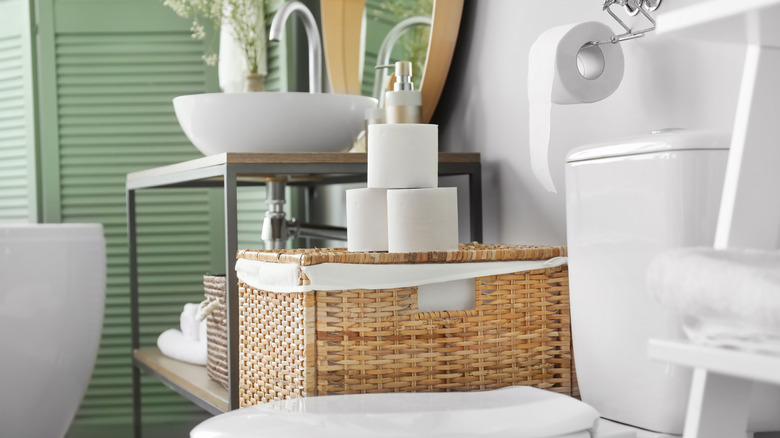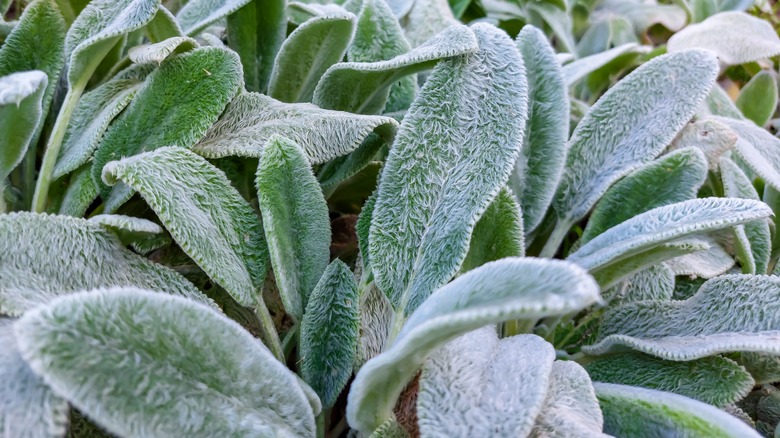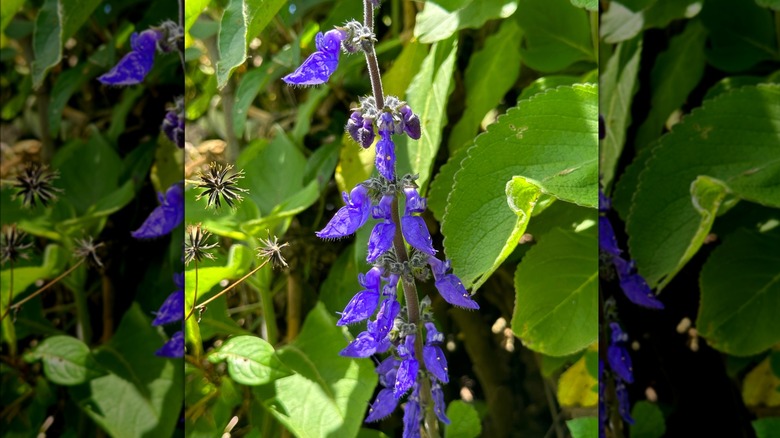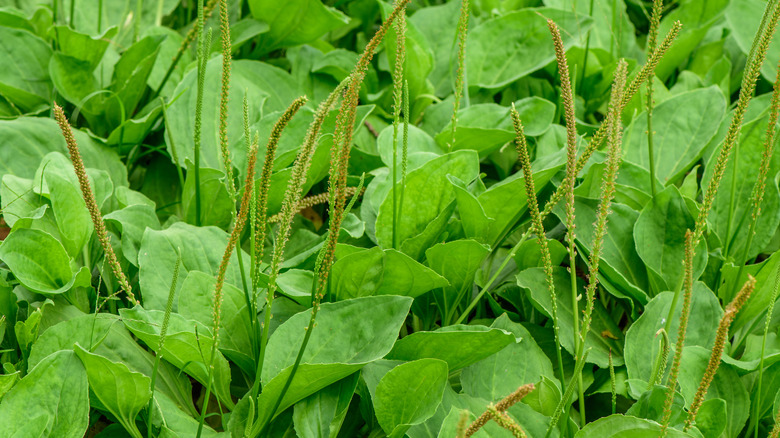Grow These Plants As An All-Natural Toilet Paper Solution
As eco-consciousness goes mainstream, many are re-evaluating their lifestyle choices, including paying for the not-so-humble toilet paper. Not only is the tree-to-flush cycle incredibly wasteful but also environmentally untenable, releasing over 26 million metric tons of carbon trapped in forests (via NRDC). This begs the question: How do we clean our tushies sustainably? Installing a bidet in your bathroom is one approach. But if you're hesitant to jump on the bidet bandwagon, switching to velvety leaves is a worthy alternative. As a bonus, you won't have to spar over supplies with doomsday TP hoarders.
If the idea of using leaves on your behind seems outlandish, surprise, surprise, this method is older than toilet paper rolls, which weren't introduced until 1857. In fact, common mullein (Verbascum Thapsus) — the invasive weed that seems to grow everywhere from gardens to roadside ditches — has racked up a reputation of being a "cowboy's toilet paper." Maybe Mother Nature had a reason for making their presence prolific. There are plenty of other plants, like lamb's ear, Indian Coleus, and broadleaf plantain that can easily substitute TP for cleaning duty while adding visual appeal to your home and garden.
Top tip: Ensure the leaves are bereft of dust and insects before using. Also, rub them first against your wrist to screen for allergic reactions over the following 24 hours. Remember, the used leaves can't be flushed, but instead, buried downhill or composted.
Lamb's ear has a downy texture
A landscaping staple, lamb's ear (Stachys byzantina) is more than a ground cover that weeds don't stand a chance against; it doubles as toilet paper. The butterfly attractant features soft, silver-green, elliptical leaves that won't hurt your butt cheeks. Since most leaves measure over 4 inches and are highly absorbent, you can finish cleaning with a few mature ones. But if you want to play it safe, grow its larger-leaved cultivars like "Big Ears." Moreover, lamb's ear has antiseptic and anti-inflammatory properties, so you can rest assured on the hygiene front.
The herbaceous perennial is evergreen in zones 4 to 8, which implies you'll have a ready supply throughout the year. Although lamb's ear tolerates dappled shade, give it full sun and well-drained soils for the best performance. Proper care will have them blooming small lavender bracts in the summer, masking the real reason for growing these TP substitutes. The plant should also be separated every couple of years to prevent it from turning aggressive. Moreover, some homeowners may find its fragrance unpleasant.
Indian Coleus' fuzzy leaves rival TP squares in size
Also known as "Kikuyu Toilet Paper," Indian Coleus (Coleus barbatus, formerly Plectranthus barbatus) has a tenacious history of having left many undersides squeaky clean, especially in Kenya, where the outhouses were purposely erected amidst these plants. It's also becoming a lot more popular among Americans, thanks to activist Robin Greenfield's "Grow Your Own Toilet Paper Initiative." Greenfield prefers calling this plant by its alternative name "Blue spur flower," as the biennial grows bluish-mauve flowers on a 10-inch-long inflorescence fall through spring.
As for its TP perks, Indian Coleus has similarly-sized, sturdy, soft leaves that resist tearing during wiping. Plus, it has a minty smell — a refreshing touch after clearing out your system. The best part, though? The leaves last about three weeks, so you don't have to pluck them first thing every morning.
To grow plants like Indian Coleus, you must be in zones 9 to 11, although zone 8 dwellers may have some luck until frost hits. Being resistant to dry conditions and droughts, the medicinal plant can go days without a drop of water. But if you prefer a lush, bushier plant, regular irrigation is necessary. Make sure to site this plant in full sun to part shade. As Coleus matures to over 6 feet tall, you'll have to pinch its foliage to contain its growth. Alternatively, you can have it adorn your sunny bathroom as a houseplant ... and easy access!
Broadleaf plantain has antiseptic properties
If you assumed the broadleaf plantain plant (Plantago major) taking over your lawn was up to no good, prepare yourself to be shocked. These mow-and trample-proof perennials boost a rosette of fairly large (over 6 inches), spineless, supple leaves that perform spectacularly as booty wipes. Depending on the task at hand, you might need several of them — they're no mullein. But they make up for their numbers by being less crumbly. Those suffering from hemorrhoids can benefit from wiping with its foliage, as it contains antiseptic and anti-itch properties.
In case broadleaf plantain isn't running amok in your yard, you can grow it in a sunny to partly-shaded area in zones 3 to 12. It will assume a more upright form in healthy soil. As the perennial self-seeds and regenerates from root crowns, it can get weedy. Prune the plant before it goes to seed, or grow in pots to prevent its spread.



